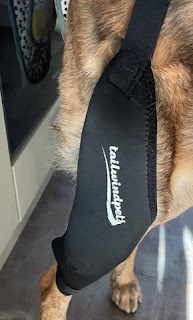Ensuring
the well-being of our furry companions is a top priority for every pet owner.
Just like humans, dogs can experience joint issues, particularly in their
knees. Whether due to injury, aging, or certain breeds' predispositions, these
joint problems can significantly impact their quality of life. Fortunately,
advancements in veterinary care offer solutions, including the use of a dog knee brace.
In this article, we'll explore how the right knee brace can help nurture your
dog's joints and enhance their mobility and comfort.
Understanding
Canine Knee Issues
Before
delving into the benefits of dog knee braces, it's essential to understand the common knee problems dogs
face. Among the most prevalent is anterior cruciate ligament (ACL) injuries,
often resulting from sudden movements or excessive strain during activities
like running or jumping. Additionally, degenerative conditions such as
osteoarthritis can afflict dogs, causing pain and stiffness in their joints,
including the knees.
The Role of Dog
Knee Braces
Knee braces for dogs serve as supportive
devices designed to alleviate discomfort and promote healing in injured or
compromised knees. These braces provide stability to the joint, reducing strain
on ligaments and cartilage while facilitating proper alignment during movement.
By supporting the knee's structure, dog braces help distribute weight
evenly, minimizing further damage and promoting a faster recovery.
Benefits of
Using Dog Knee Braces
v Pain Relief: Dog knee brace
offers relief from pain and discomfort associated with knee injuries or
conditions like arthritis. By stabilizing the joint and reducing pressure on
damaged areas, braces help alleviate strain and inflammation, enabling dogs to
move more comfortably.
v Enhanced
Mobility: Dogs wearing knee
braces often experience improved mobility and range of motion. The added
support provided by the dog brace allows them to engage in
activities they may have otherwise struggled with, such as walking, running, or
climbing stairs.
v Preventative
Measure: In addition to aiding
in recovery, dog knee braces can serve as a preventative measure against future injuries or
exacerbation of existing conditions. By providing support and stability to
vulnerable knees, braces help minimize the risk of further damage during
physical activity.
Choosing the
Right Knee Brace
Selecting
the appropriate knee brace for your dog is crucial to ensure optimal
effectiveness and comfort. Consider the following factors:
v Size and Fit: Ensure the brace fits your dog snugly without
being too tight or restrictive. Most manufacturers provide sizing guides to
help you find the right fit.
v Material and
Design: Look for dog braces made from durable, breathable materials that provide adequate
support without causing discomfort. Adjustable straps and padding can enhance
comfort and customization.
v Veterinary
Consultation: Before purchasing a dog knee brace,
consult with your veterinarian to determine the underlying cause of your dog's
knee issues and the most suitable treatment plan.
Conclusion
Investing in the right dog knee brace can make a significant difference in your dog's joint health and overall well-being. Whether recovering from an injury or managing a chronic condition, these supportive devices offer relief, mobility, and protection. By understanding your dog's specific needs and consulting with veterinary professionals, you can provide them with the care and support they need to lead a happy, active life.










